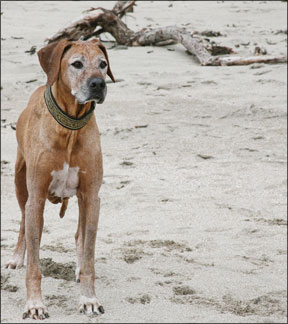Sample Homemade Low-Fat Diets for Dogs
Five owners describe their special-needs dogs’ diets.
Article by Mary Straus, published in the Whole Dog Journal, January 2009.
Also see these related articles:
- Healthy Low-Fat Diets
- Weight Loss Diets
- Pancreatitis
- Exocrine Pancreatic Insufficiency
- Cushing's Disease
Introduction
There are many health conditions that are best controlled with a low-fat diet, especially hyperlipidemia (high levels of triglycerides in the blood, even after fasting for at least 12 hours), which can lead to pancreatitis. Other conditions that may respond favorably to a low-fat diet include chronic pancreatitis, EPI (exocrine pancreatic insufficiency), IBD (inflammatory bowel disease), and lymphangiectasia. In some cases, owners may choose to reduce dietary fat for dogs who may be predisposed to pancreatitis, including those with diabetes or Cushing’s disease, or who are given anti-seizure drugs.
In Healthy Low-Fat Diets (December, 2008), we described how to calculate the amount of fat in various foods, and offered guidelines for preparing a homemade low-fat diet. This month, owners who feed their dogs home-prepared low-fat meals will share their diet plans with us.
Simple diet following acute pancreatitis
 Spenser is a six-year-old Cardigan Welsh Corgi with a history of digestive problems. His owner is Diana Thompson of Fulton, California. Following Spenser’s attack of acute pancreatitis last December, Thompson’s veterinarian tried feeding Spenser Hill’s prescription canned i/d, but Spenser would not even try the food, and the vet didn’t know what else to offer him. Here is Thompson’s account of what she found worked for her dog:
Spenser is a six-year-old Cardigan Welsh Corgi with a history of digestive problems. His owner is Diana Thompson of Fulton, California. Following Spenser’s attack of acute pancreatitis last December, Thompson’s veterinarian tried feeding Spenser Hill’s prescription canned i/d, but Spenser would not even try the food, and the vet didn’t know what else to offer him. Here is Thompson’s account of what she found worked for her dog:
While Spenser was hospitalized, with my vet’s approval, I offered him homemade dilute chicken broth, followed by slushy steamed potatoes mixed with a broth made from lean ground sirloin beef. Next I gave him some low-fat yogurt, then bits of boiled chicken breast. I fed him a couple of tablespoons of food several times a day.
Once Spenser came home from the hospital, he ate five or six small meals a day. Meals consisted of slushy potatoes, boiled chicken breast, and yogurt, a little less than ½ cup at a time. I also offered him ½ cup of diluted homemade chicken broth (25 percent broth, 75 percent water) every hour, as he wouldn’t drink plain water. The broth was made from the water I used to boil his chicken breast, with fat skimmed off.
I continued to feed small, frequent meals for the next few weeks, slowly increasing the size and decreasing the number of meals, until he was eating three meals a day. Five weeks after the attack, his blood tests were back to normal.
Today, Spenser continues to get three meals a day (even prior to the pancreatitis, he did better with more than two meals a day). For breakfast, I usually feed him 1 cup (4 oz) of cooked rice mixed with ½ cup (2 oz) ground round beef, cooked in a skillet. About one meal in five I will either substitute baked potato with skin removed for the rice, or combine rice or potato with two small scrambled eggs (2¼ oz) in place of the beef.
For dinner, Spenser usually eats 2 raw, skinless chicken necks (3 oz). If we are out of these, I’ll give him the same mixture he gets for breakfast. At bedtime, he gets a half meal consisting of ½ cup rice or potato with ¼ cup cooked ground beef or one scrambled egg.
Spenser gets slices of raw carrots to chew, and a small beef marrow bone once every couple of weeks. He also mooches from my husband’s plate, getting small amounts of just about anything that is not high in fat. I use Liver Biscotti and a few tiny kibbles of dry cat food for training rewards.
Spenser’s coat and energy are great on this diet, and he’s back to his normal weight of 30 pounds. I think feeding a simple, home-cooked diet with only a few ingredients at a time helps him stay healthy. If his stools become loose, I know that potato helps to firm them up. Now that he’s been healthy for a year, I’m planning on reintroducing The Honest Kitchen’s Verve soon to give him more variety.
My comments: At first glance, this diet looks like it might be high in fat due to the chicken necks and eggs, but both are fed in small amounts so that all of Spenser’s breakfast and dinner meals have a similar amount of fat, ranging from 6 to 8 grams of fat per meal. The overall diet is 25 percent meat and eggs, 25 percent raw meaty bones, and 50 percent carbs, and averages out to 32 grams of fat per 1,000 kcal (GFK).
I agree that adding more variety would be an improvement, particularly since Spenser is not getting any organ meat, nor a good multi-vitamin and mineral supplement. Note that there’s no need to add calcium to this diet, because it’s provided by the raw chicken necks that include bone.
A cooked diet for a dog with EPI
 Marilyn Wilson of the northern Adirondack Mountains of New York has a seven-year-old German Shepherd Dog, Annie, who was diagnosed with EPI (exocrine pancreatic insufficiency) two years ago. Wilson feeds a home-cooked diet that works well for Annie, though many dogs with EPI do not do well with fiber or grains. Following is Wilson’s description of what she feeds Annie per meal, twice a day:
Marilyn Wilson of the northern Adirondack Mountains of New York has a seven-year-old German Shepherd Dog, Annie, who was diagnosed with EPI (exocrine pancreatic insufficiency) two years ago. Wilson feeds a home-cooked diet that works well for Annie, though many dogs with EPI do not do well with fiber or grains. Following is Wilson’s description of what she feeds Annie per meal, twice a day:
I start with ½ pound of cooked meat, rotating between chicken, pork, beef, venison, rabbit, turkey, and fish (canned salmon, jack mackerel, and sardines packed in water). I’ve recently begun using chicken and beef heart along with muscle meat. I usually feed one protein for a week, then switch to another, with canned fish fed once a week. I grind the cooked meat in a food processor for easier digestibility because of Annie’s EPI.
I add ¾ cup of starchy carbohydrates, rotating between brown rice, sweet potato, quinoa, spelt, and whole-grain pasta. I overcook the grains for better digestibility. Sweet potatoes are baked and fed with the skins.
I also include 1/8 cup of fresh, raw veggies, herbs, and fruits, such as celery, spinach, parsley, cilantro, carrots, green beans, other dark leafy greens, and berries. These are pureed in a food processor. Occasionally I include nuts (such as walnuts, but never macadamia nuts, which are poisonous to dogs), or canned clams or oysters.
I add 1 teaspoon of oil, rotating among fish oil, olive oil, safflower oil, and butter, with the emphasis on fish oil.
I feed about half a pound of raw, organic liver a week, spread out over multiple meals, as too much at one time leads to loose stools. Annie doesn’t do well with eggs or cottage cheese, so I leave those out of her diet, but I often add some plain, low-fat yogurt to meals. I also give her appropriate human leftovers. Each meal is mixed with a cup of warm, filtered water, along with Annie’s prescription digestive enzymes.
I use bone meal for calcium, and give a human multi-vitamin and mineral supplement. I also give cod liver oil that provides 130 IU vitamin D twice a day during the winter when there is little sunshine.
Once a day, I add 1 tsp psyllium for fiber, human probiotics, and a sublingual (under her tongue) vitamin B12, as dogs with EPI have trouble absorbing this vitamin from their intestines. Annie was dealing with SIBO (small intestinal bacterial overgrowth, which is common in dogs with EPI) for a long time, and using these supplements helped her to recover.
I cook food once every two weeks. I remove the separable fat, plus skin from chicken, then boil the meat. I’ll cook a 40-lb case of chicken breasts in batches, using the same water each time. I put that water in the refrigerator overnight, then skim the fat off and use the liquid to cook the grains and pasta. I also bake sweet potatoes in large batches, buying 40-lb crates when they are on sale. I freeze the cooked meat in meal-sized portions, and the carbs in gallon-sized freezer bags.
I watch for sales and stock up on foods when I can. I sometimes buy whole shoulders and rump roasts. These come cryopacked, easy to freeze until I have time to defrost and cook them. When the hunting season starts, I ask hunters for any leftover venison from last year.
I make training treats out of beef liver, boiling thin slices for 10 minutes, then cutting into tiny pieces and microwaving for ten minutes or drying in the oven for an hour at 150 degrees F. I refrigerate a week’s worth and freeze the rest. I do Annie’s training right after she eats so she will still have the digestive enzymes in her system.
Both of my dogs look gorgeous and have great energy on this diet. Annie weighs around 70 pounds now, up from 50 pounds when she was at her worst. When I first started home cooking I was overwhelmed, but I actually enjoy cooking for my dogs now that I have the process streamlined.
My comments: This diet has lots of variety and good proportions of meat and carbohydrates. When using bone meal, give an amount that provides 1,000 to 1,200 mg calcium per pound of food.
Miniature Schnauzer with hyperlipidemia
 Keely, a five-year-old Miniature Schnauzer, is owned by Gail Roper, of Tucson, Arizona. A year ago, Keely’s right eye turned white. Her ophthalmologist diagnosed her with corneal fat deposits due to hyperlipidemia, which is common in Miniature Schnauzers, and advised putting Keely on a low-fat diet. Within a month, the deposits were gone. Here is Roper’s report of what she feeds her dog now:
Keely, a five-year-old Miniature Schnauzer, is owned by Gail Roper, of Tucson, Arizona. A year ago, Keely’s right eye turned white. Her ophthalmologist diagnosed her with corneal fat deposits due to hyperlipidemia, which is common in Miniature Schnauzers, and advised putting Keely on a low-fat diet. Within a month, the deposits were gone. Here is Roper’s report of what she feeds her dog now:
Keely is an agility dog who weighs 19 pounds. She gets a lot of her food during training, so her meals are small. For training, I use chicken breast and London broil (both cooked), and non-fat feta cheese, which she loves. I boil the beef, then cut it up into quarter-inch squares and freeze it. I’ve had trouble finding heart, but my grocery store said they could order it for me, so I will be using that as well.
Breakfast foods include non-fat yogurt and cottage cheese, hard-boiled eggs, sardines, 93 percent lean turkey bacon (microwaved), and chicken wingettes with as much skin removed as possible. She gets ? of a strip of bacon once or twice a week, one sardine twice a week, ½ hard-boiled egg three times a week, a tablespoon of cottage cheese and yogurt three times a week, and chicken wingettes once a week.
Dinner foods include skinless chicken breast, 93 percent lean ground turkey, salmon, and just a little bit of liver three days a week. I boil the chicken and liver, but feed the turkey raw. The salmon is left over from our meals once a week. I make 1-lb packages by mixing 9 to 10 ounces of raw turkey with 5 to 6 ounces of cooked and shredded chicken, plus a little yogurt to help with the mixing, then add ½ tsp ground eggshell per pound of meat for calcium. I add an ounce or two of liver to every other package. I then freeze each package in quart-sized freezer bags, which lasts my two dogs a couple of days. I add warm water at mealtime to make a stew.
Daily supplements include 1,000 mg fish oil, 200 IU vitamin E, 1,000 mg vitamin C, and Animal Essentials’ Herbal Multi-Vitamin Supplement. Three times a week I give a vitamin B-50 complex, and twice a week she gets 30 mg CoQ10. I hide some supplements in her food, but use a little bit of canned food for the rest.
Treats are EVO grain-free dog treats, Merrick’s dried beef lung, and homemade chicken, beef, and turkey jerky. To make jerky, I boil the meat, then cut into thin strips and bake on a cookie sheet at 250 degrees F until dehydrated. For recreation, I give her raw beef bones with marrow removed.
My comments: Even a diet without carbs can be relatively low in fat, if you’re careful about what foods you use. The dinner meal has about 36 grams of fat per 1,000 kcal.
Raw diet following acute pancreatitis
 Rowdy is a Rhodesian Ridgeback who was hospitalized with acute pancreatitis for 10 days at age 12. His owner, Jerri Langlais of Brentwood, California, was afraid to return Rowdy to a raw diet after almost losing him. Instead, she fed him Royal Canin canned low-fat prescription food.
Rowdy is a Rhodesian Ridgeback who was hospitalized with acute pancreatitis for 10 days at age 12. His owner, Jerri Langlais of Brentwood, California, was afraid to return Rowdy to a raw diet after almost losing him. Instead, she fed him Royal Canin canned low-fat prescription food.
Rowdy was troubled by borborygmi (loud intestinal rumbling noises) after eating this food and seemed uncomfortable, switching positions frequently. After three weeks, he started rejecting the prescription diet, even with added fat-free organic chicken broth or low-fat cottage cheese. Langlais decided to switch back to a homemade diet in the hopes it would help Rowdy return to normal. Here is her story:
I started with grilled skinless chicken breasts, combining half a breast with a cup of white rice that was cooked with lots of extra water and fat-free, low-sodium chicken broth. When he did well with that, I began feeding him Verve from The Honest Kitchen for one meal a day, then ½ cup green tripe every other day.
Next, I added beef heart, then beef kidney, and then raw chicken breast to his diet. I rotated among white rice, quinoa, and oatmeal, feeding these as half his diet. I then began feeding the chicken breast raw, with the bone, and giving one chicken wing. Each time I started something new, I would wait at least three days, watching for any signs of discomfort, before making any further changes.
Rowdy’s stomach noises and discomfort after eating gradually diminished, especially after I began feeding raw food. I gave him slippery elm tincture and chamomile tincture when this happened, which quieted them down within 10 minutes. Adding Primal Defense soil-based probiotics from Garden of Life (also available from Amazon) also really seemed to help.
Two months after his pancreatitis attack, Rowdy had emergency surgery for gastric dilatation-volvulus (GDV, also known as bloat). Fortunately, it was caught in time and the surgery was successful. The good news was that the surgeon said his pancreas looked normal. I fed him chicken soup, using chicken breasts boiled with white rice and grated vegetables, for five days following surgery, but he was able to resume his regular diet once his incision had healed.
Rowdy dropped from 82 to 71 pounds after his stay at the hospital, and he looked emaciated. He had difficulty gaining weight until I began feeding him 5 to 6 ounces of raw pancreas every day. I had tried giving digestive enzymes with pancreatin, but they made him gassy. As soon as I added the pancreas, his energy level increased markedly and he started gaining weight and strength. It took about four months for him to return to his normal weight.
Rowdy’s current diet consists of a large meal in the morning, usually around ¾ lb raw meaty bones. He does best with raw turkey necks. I also feed whole chicken parts with skin and fat removed, or Verve from The Honest Kitchen.
His evening meal is smaller so that he gets a total of about a pound of food a day. I rotate among green tripe, raw pancreas (once a week), beef kidney, and I’m starting to try ground beef. I no longer feed lamb, which is high in fat. Beef heart makes his stools loose if I feed too much, so I just give a small piece with his meal. Raw liver also gives him loose stool, so I feed small amounts of cooked liver as treats. If he acts hungry in the afternoon, I give him ¼ cup of nonfat yogurt. I use commercial dog cookies that are 5 percent fat.
For supplements, he gets wild salmon oil, probiotics, and algae/spirulina. Rowdy’s energy level improved dramatically when I began adding salmon oil. He gets one tablespoon three times a week, though I started with just ½ teaspoon and increased gradually once I saw that it wasn’t causing him any problems. I was alternating salmon oil with 1 tablespoon of coconut oil, but I’ve discontinued the coconut oil now that he’s back to his normal weight.
Rowdy turned 13 years old in October, and is doing really well. No more stomach sounds at all, and he plays more regularly now. The longer he is on raw, the better he seems to feel.
My comments: There’s no reason that dogs can’t return to a raw diet after recovering from acute pancreatitis, as long as you’re careful not to feed too much fat. Most raw meaty bones are high in fat, though turkey necks have less than any other kind. Rowdy’s diet is high in bone, but that’s what works best for him.
A mixed diet for a dog who wouldn’t eat
 Rocky is a 3½-year-old Yorkie-Poodle mix who has had digestive problems all of his life. From the time he was a puppy, he was a very picky eater and had frequent diarrhea. His owner, Danielle Flood, who lives in Crofton, Maryland, tried feeding all kinds of different foods to help him, but nothing seemed to work, and within a few days, he would stop eating again.
Rocky is a 3½-year-old Yorkie-Poodle mix who has had digestive problems all of his life. From the time he was a puppy, he was a very picky eater and had frequent diarrhea. His owner, Danielle Flood, who lives in Crofton, Maryland, tried feeding all kinds of different foods to help him, but nothing seemed to work, and within a few days, he would stop eating again.
One of the vets Flood consulted believes that Rocky has both IBD and chronic pancreatitis, and suggested feeding a home-cooked diet, but Rocky wasn’t interested in a mixture of chicken and rice. Rocky was down to 13 pounds of skin and bones when Flood, desperate to find a food that Rocky would eat and that wouldn’t make him sick, came across the dehydrated foods made by The Honest Kitchen. Their incomplete mix, Preference, designed to be combined with meat and other fresh foods, is very low in fat, so Flood decided to give it a try. Here is her story:
I mixed just under ¼ cup of Preference with hot water and added half of a boiled chicken breast. To my surprise Rocky devoured his entire plate and for the first time was begging for more food! Better yet, he didn’t start refusing the food after a few days, as he has with everything else we’ve tried.
A few weeks later, Rocky is still happily eating Preference mixed with chicken. We have also tried cooked chicken livers and very lean beef sirloin, and he loves those as well. He likes it best when there is a little more meat than mix.
We continue to give Rocky ? tsp acidophilus with each meal. He also gets a multi-vitamin and mineral supplement.
Treat options are very limited for Rocky, but he does very well with Free Range Chicken Breast Wraps, which we cut into tiny pieces. With our vet’s approval, we have also started giving him tiny pieces of lean raw meat (beef sirloin), which I was shocked to find he loves.
This is the longest I have ever been able to get Rocky to eat consistently. He is so excited at meal times, which is a first, actually diving into his plate to eat, and finishing completely on his own instead of my having to coax him.
We have discontinued giving Pepcid, as he no longer has an upset tummy. His stools are now normal, which they have never been before. He has gained weight, over a pound in the first two weeks, and is now up to 16 pounds and looks wonderful. Our vet, my husband, and I are delighted and relieved to see Rocky healthy, happy, eating, playing, and in no pain.
Update 18 months later:
Rocky is doing fantastic! We have even been able to substitute some of the Preference meals with a dry kibble now too, which is very exciting for us especially when we are traveling or when he gets bored. The dry kibble is U.S. Grains Regal Sensi-Bites. This has been wonderful for us and Rocky enjoys mixing things up without getting a flare up!
My comments: This is a good example of perseverance paying off. There are many different types of foods available; if kibble and canned don’t work for your dog, try something else. Pre-mixes are a great way to feed fresh foods, without having to worry about balancing a homemade diet.
I regret that I no longer have much time to respond to questions. See my Contact page for more information. My name is Mary Straus and you can email me at either or

